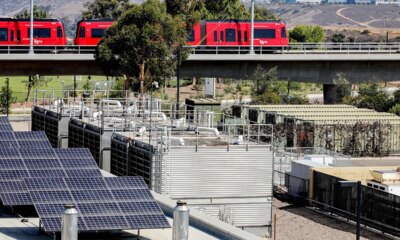California
Endangered plant may have made California wildfires worse

A move to protect a federally endangered plant by halting the state construction of new utility lines is being highlighted in a newspaper report as a potential factor in California’s Palisades fire.
Downed utility lines in the area are being investigated for fuelling, and potentially even causing, the immense Palisades fire, says The New York Times.
However, the California Coastal Commission, who intervened in the utility line construction, have said that they did give out new permits for the utility pole project and “are very supportive of wildfire resiliency work.”
Why It Matters
The cause of the Pacific Palisades fire is under investigation by the Bureau for Alcohol, Tobacco, Firearms, and Explosives (ATF), and if government negligence was found to play a part, it would further fuel existing frustration with Mayor Bass, and Governor Newsom expressed by some California residents.
LA is also facing a climate-change-shaped future of increased droughts which will further impact the scope of wildfires, and needs to figure out how to balance everyday conservation with fire protection for the entire region.
Left: Michael Charters, Right: Carolyn Kaster/Left: US Forest Service, Right: Associated Press
What To Know
In 2020, the California Coastal Commission fined the Los Angeles Department of Public Works (LADWP) $1.9 million over their utility pole project in the Pacific Palisades, as the project had bulldozed almost 200 federally protected Braunton’s milkvetch (Astragalus brauntonii) plants.
According to the Sierra Club, there are only 3,000 of these “purple-petalled perennial wildflower” plants left in the mountains, and they are listed under the Endangered Species Act.
The utility pole project policed by the Coastal Commission in 2020 was a public works project designed to install stronger, metal, utility poles in the Palisades, as some of the utility poles in the area were built almost 100 years ago. Downed utility lines have caused blazes in the past, and reporters from The New York Times have now found bits of power line debris in the Palisade hills.
The Coastal Commission told the LADWP in 2020 that they needed to seek a permit from the Coastal Commission to restart the development, as well as undo their roadwork and revegetate the area. While the LADWP paid the fine, it does not appear they ever restarted the utility poles project.
The LADWP has been contacted via phone call and voicemail for comment.
Sarah Christie, a spokesperson for the Coastal Commission, spoke to Newsweek about this incident saying: “In 2019, a hiker reported unpermitted bulldozing through an area of endangered plants and hiking trails in Topanga State Park.
“In addition to damaging native plants and public trails, this type of grading also can also encourage highly flammable, non-native grasses to flourish. But the damage was repaired the following year, and the Commission approved a permit for the Utility to move forward with their work to replace the poles.
“We are very supportive of wildfire resiliency work and will continue to promote efforts to harden homes and public infrastructure and create defensible space.”
What People Are Saying
Eric Edmunds, Chair of the Santa Monica Mountains Task Force in a 2020 letter: “Our task force has been involved with far too many cases of utility companies not using good judgment and failing to comply with the laws, policies, and ordinances that are in place to protect and preserve our finite natural resources.”
The LADWP in 2020: “[This project is] essential in regards to our wildfire mitigation plan.”
What Happens Next
The cause of the Palisades fire is still under investigation by the ATF, who have said it will take time to figure out the root cause of the blaze.
In the meantime, Angelenos are still combating active blazes, with the Eaton fire now at 55 percent containment, and the Palisades fire at 22 percent containment.

California
Southern California forecast: Sunshine and summer-like temps expected all week

LOS ANGELES – It may be too warm to wear your favorite holiday sweater this week.
Amid the holiday season, Southern California will experience summer-like weather, with warm and dry conditions expected to last through Wednesday.
What we know:
The region will experience above-average temperatures as high pressure builds in Southern California.
Inland communities can expect highs around 81 degrees, while coastal areas will enjoy sunny skies with temperatures reaching 72 degrees. The warmest spots, such as in the Inland Empire, may see temperatures as high as 87 degrees. Meanwhile, the Pacific Northwest is experiencing heavy rainfall due to an atmospheric river, which is deflecting storms away from Southern California.
Timeline:
Monday and Tuesday:
- Summer-like weather with warm and dry conditions.
- Morning patchy fog followed by afternoon sunshine.
- Inland temperatures around 81 degrees; coastal areas at 72 degrees.
Through Wednesday:
- Continuation of warm and dry weather.
- High pressure maintains above-normal temperatures.
Weekend:
- Gradual decrease in temperatures.
- Shift from offshore to onshore winds.
- Inland temperatures may reach up to 87 degrees before cooling.
What’s next:
By the weekend, a shift from offshore to onshore winds will help bring temperatures down slightly. In addition, no rain is anticipated in the next seven days.
The Source: This story was written with information provided by the National Weather Service and FOX 11’s Weather Team.
California
Comic shop burglary in Southern California puts cat rescue at risk

Cats & Comics Rescue, a downtown Upland shop that relies on the sale of comic books and collectibles to support the care of dozens of rescue cats, is recovering from a break-in that occurred early Friday morning. Surveillance footage shows a suspect shattering the front entrance around 5 a.m. and heading directly for the store’s display cases, taking rare comic books, Pokémon cards and other items before fleeing.
Jeremy Guerra, the shop’s owner, said the financial loss is substantial. While the full scope of the theft is still being assessed, he estimated that the value of stolen comics alone exceeds $5,000. The impact, he said, extends beyond merchandise. The sales of those items help fund the rescue operation located within the same space, covering medical care, food and other essentials for cats awaiting adoption. The shop is currently caring for 22 cats.
“The reason why we do cats and comics is because the cat rescue doesn’t survive alone,” Guerra said. “This is the big part, it’s the comics and card sales, that’s what keeps us alive.”
The shop allows visitors to spend time with the animals for a $5 fee, and all cats are available for adoption at an additional cost that includes vaccinations, spay or neuter services and deworming. The space doubles as a comic store and an animal sanctuary, offering a space where customers can both browse and connect with the cats waiting to be adopted.
After news of the break-in spread, community members began offering support. A mother and daughter arrived with donations of cat food and cash, contributions Guerra described as deeply moving. “When people bring in donations, it does get me teary-eyed, for sure,” he said.
Despite the setback, Guerra said the community’s response has affirmed the shop’s mission. Those who wish to contribute can donate online or provide items such as cat food.
Cats & Comics Rescue remains open daily at 136 E. 9th St. from 10 a.m. to 9 p.m. Information about supporting the rescue or adopting a cat is available through the shop’s official website.
Jillian Smukler’s reporting contributed to this article.
California
Warning against mushroom foraging in California after fatal poisoning

Officials in California are urging people not to forage for wild mushrooms after a rise in poisoning cases caused at least one death.
The California Poison Control System has identified 21 cases of amatoxin poisoning clustered in northern California, likely resulting from death cap mushrooms, the state’s department of public health said.
The poisoning resulted in severe liver damage in several people, including children, and at least one of the patients may need a liver transplant, the department said.
Death cap mushrooms can easily be mistaken for safe, edible mushrooms because of their similar taste, smell, and appearance.
The confirmed cases happened between mid-November and early December, a rainy season in the region that creates ideal conditions for the deadly variety to grow, mostly near oaks and hardwood trees like pine trees, the California Department of Public Health (CDPH) said.
Though the cases are mostly in the Monterey and San Francisco Bay area of Northern California, the risk is statewide, the department warned.
“Death cap mushrooms contain potentially deadly toxins that can lead to liver failure,” Dr Erica Pan, CDPH Director and State Public Health Officer, said in a statement. “Because the death cap can easily be mistaken for edible safe mushrooms, we advise the public not to forage for wild mushrooms at all during this high-risk season.”
The death cap mushroom is never safe to eat, even if it is boiled, dried, frozen or cooked.
Eating the deadly mushrooms can cause watery diarrhoea, nausea, vomiting, abdominal pain and dehydration within six to 24 hours – and although symptoms may initially wane, severe or fatal liver damage can still occur up to eight days later.
“Only people with extensive training and experience should eat wild mushrooms that they have picked themselves,” Dr Edward Moreno, County of Monterey Health Officer, said in a statement.
-

 Alaska2 days ago
Alaska2 days agoHowling Mat-Su winds leave thousands without power
-
Ohio4 days ago
Who do the Ohio State Buckeyes hire as the next offensive coordinator?
-

 Politics6 days ago
Politics6 days agoTrump rips Somali community as federal agents reportedly eye Minnesota enforcement sweep
-

 News6 days ago
News6 days agoTrump threatens strikes on any country he claims makes drugs for US
-

 World6 days ago
World6 days agoHonduras election council member accuses colleague of ‘intimidation’
-

 Texas3 days ago
Texas3 days agoTexas Tech football vs BYU live updates, start time, TV channel for Big 12 title
-

 Miami, FL2 days ago
Miami, FL2 days agoUrban Meyer, Brady Quinn get in heated exchange during Alabama, Notre Dame, Miami CFP discussion
-

 Cleveland, OH1 day ago
Cleveland, OH1 day agoMan shot, killed at downtown Cleveland nightclub: EMS






































